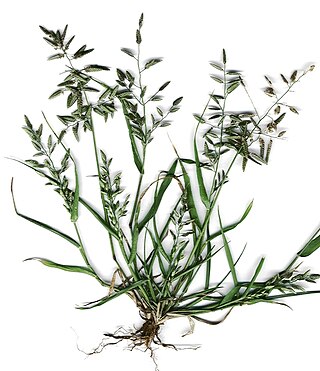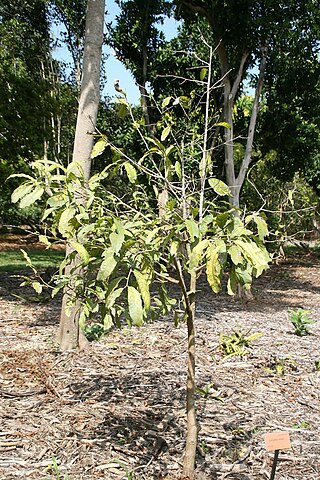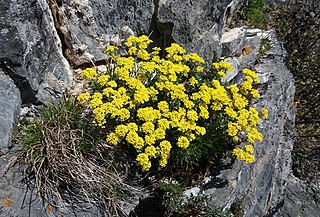Related Research Articles

Lutetium is a chemical element with the symbol Lu and atomic number 71. It is a silvery white metal, which resists corrosion in dry air, but not in moist air. Lutetium is the last element in the lanthanide series, and it is traditionally counted among the rare earth elements; it can also be classified as the first element of the 6th-period transition metals.

Sodium is a chemical element with the symbol Na and atomic number 11. It is a soft, silvery-white, highly reactive metal. Sodium is an alkali metal, being in group 1 of the periodic table. Its only stable isotope is 23Na. The free metal does not occur in nature, and must be prepared from compounds. Sodium is the sixth most abundant element in the Earth's crust and exists in numerous minerals such as feldspars, sodalite, and halite (NaCl). Many salts of sodium are highly water-soluble: sodium ions have been leached by the action of water from the Earth's minerals over eons, and thus sodium and chlorine are the most common dissolved elements by weight in the oceans.

Eragrostis is a large and widespread genus of plants in the grass family, found in many countries on all inhabited continents and many islands.

A perennial plant or simply perennial is a plant that lives more than two years. The term is often used to differentiate a plant from shorter-lived annuals and biennials. The term is also widely used to distinguish plants with little or no woody growth from trees and shrubs, which are also technically perennials.

Phytoremediation technologies use living plants to clean up soil, air and water contaminated with hazardous contaminants. It is defined as "the use of green plants and the associated microorganisms, along with proper soil amendments and agronomic techniques to either contain, remove or render toxic environmental contaminants harmless". The term is an amalgam of the Greek phyto (plant) and Latin remedium. Although attractive for its cost, phytoremediation has not been demonstrated to redress any significant environmental challenge to the extent that contaminated space has been reclaimed.

Salix viminalis, the basket willow, common osier or osier, is a species of willow native to Europe, Western Asia, and the Himalayas.
A hyperaccumulator is a plant capable of growing in soil or water with very high concentrations of metals, absorbing these metals through their roots, and concentrating extremely high levels of metals in their tissues. The metals are concentrated at levels that are toxic to closely related species not adapted to growing on the metalliferous soils. Compared to non-hyperaccumulating species, hyperaccumulator roots extract the metal from the soil at a higher rate, transfer it more quickly to their shoots, and store large amounts in leaves and roots. The ability to hyperaccumulate toxic metals compared to related species has been shown to be due to differential gene expression and regulation of the same genes in both plants.

Rhizofiltration is a form of phytoremediation that involves filtering contaminated groundwater, surface water and wastewater through a mass of roots to remove toxic substances or excess nutrients.
The Greenwich Peninsula Ecology Park is a park situated along the River Thames in the Greenwich Peninsula in South London. The park reflects the nature of the original marshland on the peninsula. The park provides a haven for many different species of bird, plants and bugs and acts as an important brownfield land to control urban sprawl. The park is a partnership project of Homes and Communities Agency (HCA) and now managed by The Conservation Volunteers (TCV). The area of the park is 11 hectares and is half aquatic and half terrestrial. Development was completed in 2000 and the park opened to public in 2002. In April 2011 the Trust took on the management of a new site nearby, the Meantime Nursery, with aims to create on vacant development land a resource for the community and for nature conservation. The park is a Site of Borough Importance for Nature Conservation, Grade I.
Streptanthus polygaloides is a species of flowering plant in the mustard family known by the common name milkwort jewelflower. It is endemic to the Sierra Nevada foothills of California, where it grows in woodlands and chaparral, generally on serpentine soils.
Phytoextraction is a subprocess of phytoremediation in which plants remove dangerous elements or compounds from soil or water, most usually heavy metals, metals that have a high density and may be toxic to organisms even at relatively low concentrations. The heavy metals that plants extract are toxic to the plants as well, and the plants used for phytoextraction are known hyperaccumulators that sequester extremely large amounts of heavy metals in their tissues. Phytoextraction can also be performed by plants that uptake lower levels of pollutants, but due to their high growth rate and biomass production, may remove a considerable amount of contaminants from the soil.
Athyrium yokoscense, commonly known as Asian common ladyfern in English and as Hebino-negoza in Japanese, is a species of fern in the family Athyriaceae. These tough plants live primarily in and around mine sites and thrive in soils contaminated with high concentrations of heavy metals, such as zinc, cadmium, lead, and copper. A. yokoscense is indigenous to Japan, Korea, eastern Siberia and northeastern China and has been known for centuries to tolerate phytotoxic mining sites. The predominance and concentration of this fern species at a particular region was used to identify potential mining sites. The primary potential of A. yokoscense is in its phytoremediative ability to accumulate toxic metals from soils contaminated with heavy metals, so it may have some long-term commercial importance. No medicinal or culinary values of this fern species have been studied or confirmed.

Pycnandra acuminata is a species of plant in the family of Sapotaceae. It is a rainforest shrub, endemic to New Caledonia, and is adapted to the nickel-rich ultramafic soils found there. Pycnandra acuminata is notable as one of the most prolific hyperaccumulators of trace metals known, actively absorbing nickel from the soil and concentrating it within the plant to a concentration of up to 25% nickel citrate as dry weight of the sap, which is turquoise-green in colour due to the nickel content. the only known plant with turquoise sap. An excellent photo can be seen at. The vernacular name in French is sève bleue.

Vigna luteola, commonly known as the hairy cowpea and the Nile bean, is a perennial vine found in many tropical areas.

Lecythis minor, the monkey-pot tree, is a small tree with toxic seeds that occurs in South America.

Phyllanthus balgooyi is an herbaceous plant in the family Phyllanthaceae, found in Palawan and Sabah. The plant is a hyperaccumulator of nickel, with a concentration of the metal exceeding 16% in the plant's phloem sap.

Hennecartia is a monotypic genus of flowering plants belonging to the family Monimiaceae. The only species is Hennecartia omphalandra.

Odontarrhena is a large genus of flowering plants in the family Brassicaceae. They were originally a separate genus and then were amalgamated into the Alyssum genus, but then morphological and molecular evidence has reseperated them. Some of the genera are nickel (Ni) hyperaccumulators.

Agrostis castellana, the highland bent, dryland bent or dryland browntop, is a species of cool-season grass in the family Poaceae. It is native to Macaronesia and the Mediterranean, has been widely introduced elsewhere, and is considered an invasive species in some locales. It is a hyperaccumulator of zinc and lead.
References
- ↑ CRC dictionary of agricultural sciences, Robert Alan Lewis, CRC Press, 2001, ISBN 0-8493-2327-4
- ↑ Ecosystems of Disturbed Ground, Lawrence R Walker, Elsevier, 1999, ISBN 0-444-82420-0
- ↑ Ginocchio, Rosanna; Baker, Alan J.M. (2004), "Metallophytes in Latin America: a remarkable biological and genetic resource scarcely known and studied in the region", Revista chilena de historia natural , 77 (1): 185–194, doi: 10.4067/S0716-078X2004000100014